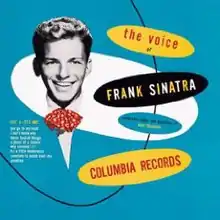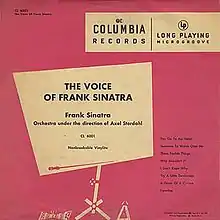| The Voice of Frank Sinatra | ||||
|---|---|---|---|---|
 | ||||
| Studio album by | ||||
| Released | March 4, 1946 | |||
| Recorded | July 30, 1945 Hollywood December 7, 1945 New York City | |||
| Genre | Traditional pop | |||
| Length | 24:01 | |||
| Label | Columbia C-112 (78 rpm) Columbia CL-6001 (33 rpm) Legacy CK62100 | |||
| Frank Sinatra chronology | ||||
| ||||
| Alternative cover | ||||
 The 1948 reissue as the first LP record developed by Columbia Records | ||||
| Review scores | |
|---|---|
| Source | Rating |
| Allmusic | |
The Voice of Frank Sinatra is the debut studio album by American singer Frank Sinatra, released on Columbia Records, catalogue C-112, March 4, 1946. It was first issued as a set of four 78 rpm records totaling eight songs, the individual discs given Columbia 78 catalog numbers 36918, 36919, 36920, and 36921.[2] The album went to number 1 on the fledgling Billboard chart. It stayed at the top for seven weeks in 1946, spending a total of eighteen weeks on the charts. The album chart consisted of just a Top Five until August 1948. The cover depicted is that of the original 78 rpm release cover, also used on the compact disc reissue.
Content
The tracks were arranged and conducted by Axel Stordahl and his orchestra, on both dates consisting of a string quartet and four-piece rhythm section, augmented by flutist John Mayhew in July, and, given the part he played with Sinatra at Columbia in the early 1950s, oboist Mitch Miller in December. Sinatra recorded most of these songs again at later stages in his career.
Certain critics have claimed The Voice to be the first concept album. Beginning in 1939, however, singer Lee Wiley started releasing albums of 78s dedicated to the songs of a single writer, such as Cole Porter, a precursor to the Songbooks sets formulated by Norman Granz and Ella Fitzgerald in 1956. These may loosely be termed concept albums, although with The Voice, Sinatra inaugurated his practice of having a common mood, theme, or instrumentation tying the songs together on a specific release.
It also holds the distinction of being the first pop album catalogue item at 33⅓ rpm, when Columbia premiered long-playing vinyl records in 1948, ten-inch and twelve-inch format for classical music, ten-inch only for pop. The Voice was reissued as a 10-inch LP, catalogue number CL 6001 in 1948, with the running order altered from the sequence of the original album of 78s. It was also later issued as two 45 rpm EPs in 1952 with catalogue number B-112, a 12-inch LP with a changed running order including only five of the original tracks in 1955 with catalogue number CL-743, and a compact disc with extra tracks in 2003.[3]
Track listing
10-inch LP release
| No. | Title | Writer(s) | Length |
|---|---|---|---|
| 1. | "You Go to My Head" (Columbia 36918) | Haven Gillespie, J. Fred Coots | 3:00 |
| 2. | "Someone to Watch Over Me" (Columbia 36921) | George Gershwin, Ira Gershwin | 3:18 |
| 3. | "These Foolish Things" (Columbia 36919) | Holt Marvell, Jack Strachey, Harry Link | 3:08 |
| 4. | "Why Shouldn't I?" (Columbia 36920) | Cole Porter | 2:53 |
| No. | Title | Writer(s) | Length |
|---|---|---|---|
| 1. | "I Don't Know Why" (Columbia 36918) | Roy Turk, Fred E. Ahlert | 2:46 |
| 2. | "Try a Little Tenderness" (Columbia 36920) | Harry M. Woods, James Campbell, Reginald Connelly | 3:08 |
| 3. | "I Don't Stand a Ghost of a Chance with You" (Columbia 36919) | Bing Crosby, Ned Washington, Victor Young | 3:11 |
| 4. | "Paradise" (Columbia 36921) | Nacio Herb Brown, Gordon Clifford | 2:37 |
2003 reissue bonus tracks
| No. | Title | Writer(s) | Length |
|---|---|---|---|
| 9. | "Mam'selle" | Mack Gordon, Edmund Goulding | 3:26 |
| 10. | "That Old Feeling" | Lew Brown, Sammy Fain | 3:19 |
| 11. | "If I Had You" | Ted Shapiro, Campbell, Connelly | 3:01 |
| 12. | "The Nearness of You" | Ned Washington, Hoagy Carmichael | 2:41 |
| 13. | "Spring is Here" | Richard Rodgers, Lorenz Hart | 2:42 |
| 14. | "Fools Rush In" | Johnny Mercer, Rube Bloom | 3:01 |
| 15. | "When You Awake" | Henry Nemo | 3:07 |
| 16. | "It Never Entered My Mind" | Rodgers, Hart | 3:09 |
| 17. | "Always" | Irving Berlin | 2:55 |
| 18. | "(I Don't Stand) A Ghost of A Chance (with You)" (alternate take) | Crosby, Washington, Young | 3:32 |
1955 track listing
| No. | Title | Writer(s) | Length |
|---|---|---|---|
| 1. | "I Don't Know Why (I Just Do)" | Turk, Ahlert | 2:43 |
| 2. | "Try a Little Tenderness" | Woods, Campbell, Connelly | 3:03 |
| 3. | "(I Don't Stand) A Ghost of A Chance (with You)" | Crosby, Washington, Young | 3:16 |
| 4. | "Paradise" | Brown, Clifford | 2:41 |
| 5. | "These Foolish Things (Remind Me of You)" | Marvell, Strachey, Link | 3:15 |
| 6. | "Laura" | Johnny Mercer, David Raksin | 3:17 |
| No. | Title | Writer(s) | Length |
|---|---|---|---|
| 1. | "She's Funny That Way" | Neil Moret, Richard A. Whiting | 3:25 |
| 2. | "Fools Rush In (Where Angels Fear to Tread)" | Mercer, Bloom | 3:04 |
| 3. | "Over The Rainbow" | Yip Harburg, Harold Arlen | 3:20 |
| 4. | "That Old Black Magic" | Mercer, Arlen | 2:37 |
| 5. | "Spring Is Here" | Rodgers, Hart | 2:42 |
| 6. | "Lover" | Rodgers, Hart | 2:39 |
Personnel
- Frank Sinatra – vocal
- Axel Stordahl – arranger
New York sessions
- Leonard Posner. Raoul Polikian – violins
- Sidney Brecher – viola
- Anthony Sophos – cello
- Mitch Miller – oboe
- Matty Golizio – guitar
- Bill Clifton – piano
- Frank Siravo – bass
- Nat Polen – drums
Hollywood sessions
- Mischa Russell, David Frisina – violins
- Sam Freed – viola
- Fred Goerner – cello
- Jack Mayhew – flute
- George Van Eps – guitar
- Mark McIntyre – piano
- John Ryan – bass
- Ray Hagan – drums
Production personnel
- Bill Richards – producer
- Charles L. Granata, Didier C. Deutsch – compact disc reissue producers
Charts
- Weekly Charts
| Chart (1946) | Peak position |
|---|---|
| US Billboard Best-Selling Popular Record Albums[4] | 1 |
- Year-end charts
| Chart (1946) | Position |
|---|---|
| US Billboard Best-Selling Popular Record Albums[5] | 2 |
References
- ↑ AllMusic review
- ↑ Sinatra Family Discography website retrieved 30 July 2019
- ↑ Charles L. Granata, The Voice of Frank Sinatra. 2003, Columbia Legacy CK 62100, liner notes.
- ↑ "Best-Selling Popular Record Albums". Billboard. April 6, 1946. p. 32. Retrieved March 29, 2021 – via Google Books.
- ↑ "Best-Selling Popular Record Albums". Billboard. January 4, 1947. p. 2. Retrieved April 7, 2021 – via Google Books.